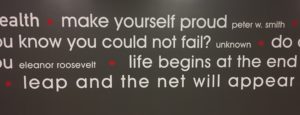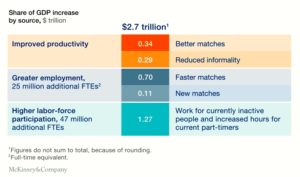 In my last post, I talked about the extreme highs and lows of my first 30 days in business, even threating to jump on a plane and run away from it all. Well, 90 days later I’m still at it, with no plans of catching a plane anytime soon.
In my last post, I talked about the extreme highs and lows of my first 30 days in business, even threating to jump on a plane and run away from it all. Well, 90 days later I’m still at it, with no plans of catching a plane anytime soon.
We now have financing, clients, and a corporate identity. Still plenty of work to do but the focus is now on building the pipeline and less on losing my house, our retirement, and so many other things that will go through your head late at night while second-guessing yourself.
Fortunately for my sanity, our building has a gym on the ground floor. It’s a great way to start the day or take a mid-day mental break to recharge (I highly encourage it). On the back wall, there are inspirational quotes to help keep you motivated. One, in particular, has had a certain relevance to me during this phase in my life;” Leap and the net will appear.”
Here are 6 new things I’ve learned since taking the leap:
- Everything (and I mean everything) will take 30 to 60 days longer than expected – be it a loan, new project or client, even a business card order will take longer than anticipated (if you’re a novice). Add days to your expectations, push timelines out and start earlier than you planned. There are certain things out of your control and you may be less frustrated you if you keep this in mind…or maybe not.
- Get half decent at everything – if you’re starting a business you are obviously knowledgeable, passionate and perhaps even an expert at something. Similarly, you’ll lack knowledge or depth in other areas. What I’ve learned is it is crucial to get a working level of knowledge on just about everything. You don’t have to be the “expert” but you have to have a base of knowledge to give direction to your advisors/experts (like attorneys, accounts, designers). Fortunately, there are plenty of good resource sites available (for example, com).
- Trust your network – the “net” that will appear once you leapt will come from your network. You likely have more people in your circle that can, or will help you along your journey than you realize. One of my most trusted advisors turned out to be someone I’ve known socially for close to twenty years. It wasn’t until 60 days into this journey that I thought of him. You will be surprised by the support of friends, family and even acquaintances. If they can’t help you directly, there is a good chance they’ll know someone that can. Your network will be one of your most valuable assets, mine it.
- Surprising financing options – depending on how your business is organized you may be able to take advantage of your 401K to fund the business or give yourself a line of credit. If you establish the business as a “C” corporation you can use your 401K as capital to buy a franchise or business or to fund it. There are some potential downsides to consider, so please consult a tax attorney or accountant before moving forward.
- SEP IRA – speaking of 401K’s you may be deferring your 401K contributions like I am until the business is profitable. The Simplified Employee Pension (SEP) allows for a contribution of up to 25% of an employee’s pay up to $55,000 in 2018. As your business takes off your SEP gives you an opportunity to catch up on your retirement savings.
- Payment terms of 60 days or longer – are pure evil for a startup. It’s absolutely ridiculous for a large corporation to expect a small business to float them for any period of time after a project has been completed. Cash flow is king and it’s also a killer for small businesses. As soon as we reach a certain level of success, we will actively avoid contracts with payment terms of that length. The learning, make sure you invoice your client as soon as the contract is signed! Billion dollar corporation, encourage procurement to develop new payment terms for small businesses. You can, and should, support the growth of new businesses. We may end up being your innovation incubator.
There is another quote on the wall I mentioned earlier. It’s by Eleanor Roosevelt and I find myself staring at frequently,
“Do One Thing Every Day that Scares You.”
Yeah, I pretty much have that one nailed. Talk to you again in 6 months. #buildingcarbondesign

